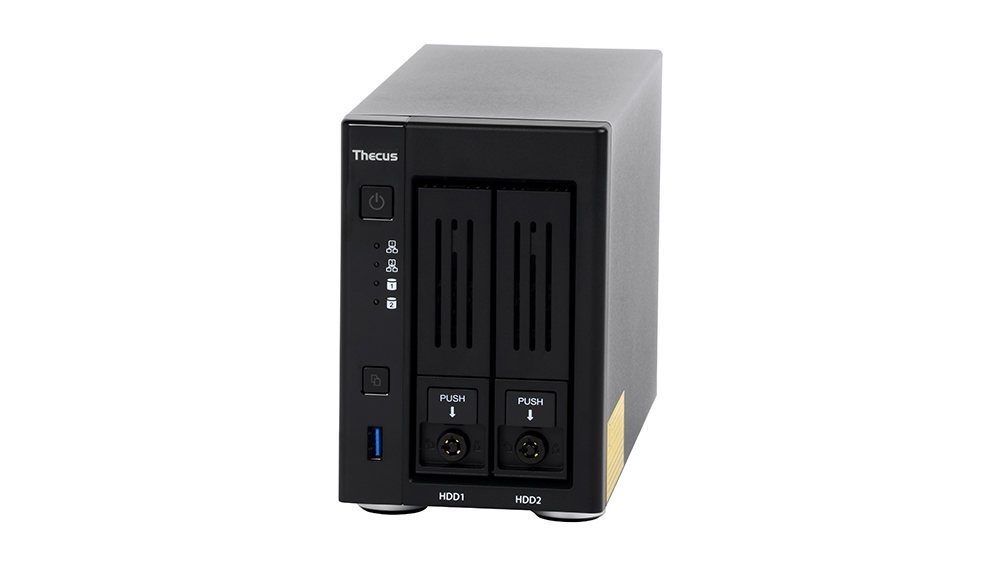Thecus N2810 review
Proving that speed isn’t everything, this fast, powerful NAS is hobbled by ornery software

The Thecus N2810 is incredibly speedy, but hampered by complex setup and an unwieldy, confusing UI. This is a powerful NAS capable of handling high-end tasks and workloads, but Thecus needs to sort out the software.
-
+
Very quick speeds; Excellent connectivity options; Loads of options for expert users;
-
-
Drive bay design is slightly awkward; Setup, configuration and operation is unintuitive & tedious;

This two-bay NAS is definitely speedy. With a 1.6GHz Broadwell Celeron N2050 processor and a healthy 2GB of DDR3 RAM, the Thecus N2810 is one of the fastest units we've tested recently, beating the Qnap TS-451+ with an average write speed of 106.8MB/sec in our large video file transfer test and coming a close second for read speeds. Only a slightly-less-than-stellar effort in our small files transfer tests prevented it from topping the performance table.
Connectivity is another strength, with dual Gigabit Ethernet ports supporting link bonding, three USB 3 ports, with one handy at the front, and an HDMI output that enables the N2810 to double as a media player as well as server. With built-in transcoding abilities, it's certainly equipped for the job.
On other fronts, however, it's less than ideal. Like the TS-451+, the design is more functional than fancy, but the metallic chassis transmits more drive noise. The drives aren't so easy to fit, partly because the clip mechanism that holds them into their hot-swap caddies is awkward, and partly because the instructions don't cover installation.
The Thecus Setup Wizard used to locate your drive across the network is similarly basic, and by default put our unit on a separate network segment so that we couldn't see it from our workstation. Oddly, the RAID setup defaults to a JBOD configuration rather than the more conventional RAID0 or RAID1.
Things don't get much better once you get it up and running. Thecus provides a huge range of options for advanced users and a decent selection of add-on modules to download and install, but the control panels are complex, jargon-heavy and intimidating. It can be hard to understand the panels and the terminology being used, while even installing apps isn't hassle-free.
You can install the TwonkyMedia or Plex media servers or set up remote access through WebDAV and an accompanying mobile app but Thecus doesn't make the process easy, and setting up any sync service is even more challenging. This is a powerful NAS capable of handling high-end tasks and workloads, but Thecus needs to sort out the software.
This review originally appeared in PC Pro issue 261.
Verdict
The Thecus N2810 is incredibly speedy, but hampered by complex setup and an unwieldy, confusing UI. This is a powerful NAS capable of handling high-end tasks and workloads, but Thecus needs to sort out the software.
Get the ITPro daily newsletter
Sign up today and you will receive a free copy of our Future Focus 2025 report - the leading guidance on AI, cybersecurity and other IT challenges as per 700+ senior executives
Stuart has been writing about technology for over 25 years, focusing on PC hardware, enterprise technology, education tech, cloud services and video games. Along the way he’s worked extensively with Windows, MacOS, Linux, Android and Chrome OS devices, and tested everything from laptops to laser printers, graphics cards to gaming headsets.
He’s then written about all this stuff – and more – for outlets, including PC Pro, IT Pro, Expert Reviews and The Sunday Times. He’s also written and edited books on Windows, video games and Scratch programming for younger coders. When he’s not fiddling with tech or playing games, you’ll find him working in the garden, walking, reading or watching films.
You can follow Stuart on Twitter at @SATAndrews.
-
 CyberOne appoints Microsoft’s Tracey Pretorius to its advisory board
CyberOne appoints Microsoft’s Tracey Pretorius to its advisory boardNews The threat intelligence leader will provide strategic guidance to CyberOne’s executive team
By Daniel Todd Published
-
 CISA issues warning in wake of Oracle cloud credentials leak
CISA issues warning in wake of Oracle cloud credentials leakNews The security agency has published guidance for enterprises at risk
By Ross Kelly Published
-
 Reports: White House mulling DeepSeek ban amid investigation
Reports: White House mulling DeepSeek ban amid investigationNews Nvidia is caught up in US-China AI battle, but Huang still visits DeepSeek in Beijing
By Nicole Kobie Published